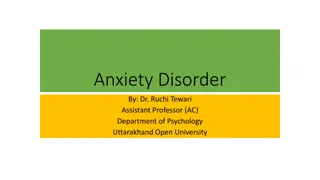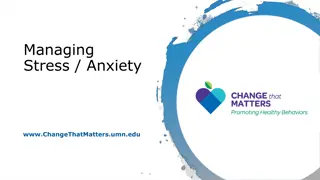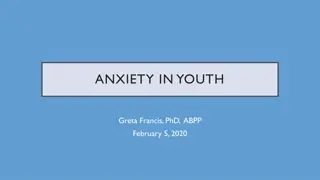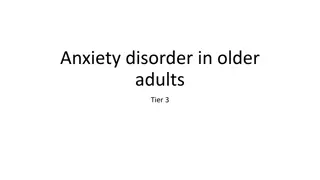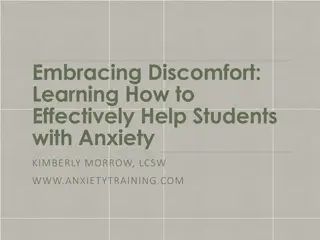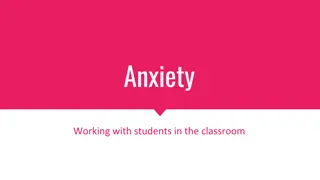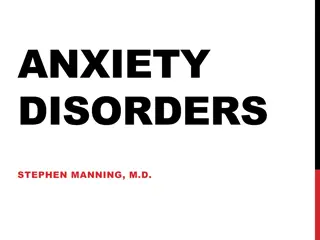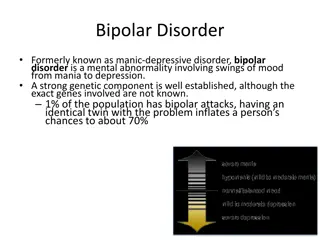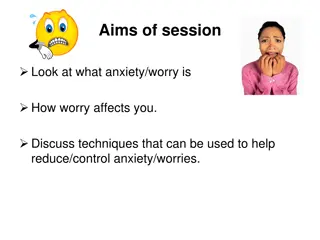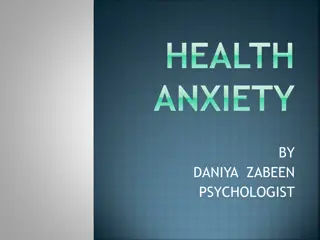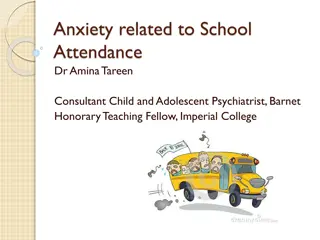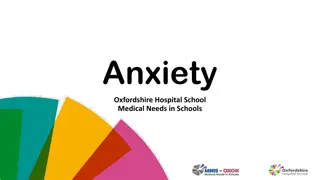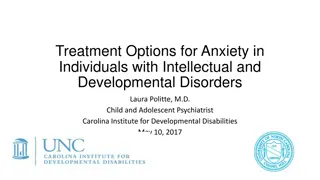Understanding and Treating Anxiety Disorders: A New Approach Presented by Todd Pressman, Ph.D.
Explore the Deconstructing Anxiety model which delves into the fundamental drives of human experience, the birth of fear in the psyche, and the role of perception in shaping an anxious reality. Discover how separation from fulfillment leads to anxiety and fear, impacting our perception of reality. Gain insights into the creation story revisited and learn about the significant impact anxiety has on individuals in the U.S., making it the top psychiatric disorder. Dive into a powerful new approach to comprehending and managing anxiety disorders effectively.
Download Presentation

Please find below an Image/Link to download the presentation.
The content on the website is provided AS IS for your information and personal use only. It may not be sold, licensed, or shared on other websites without obtaining consent from the author. Download presentation by click this link. If you encounter any issues during the download, it is possible that the publisher has removed the file from their server.
E N D
Presentation Transcript
DECONSTRUCTING ANXIETY A Powerful New Approach to Understanding and Treating Anxiety Disorders Presented by Todd Pressman, Ph.D.
Anxiety in the U.S. According to the National Institute of Mental Health: Anxiety is the number one psychiatric disorder in the U.S. today. More than 18 percent of adults in the U.S. have a diagnosed anxiety disorder. We are the most anxious nation in the world. More than $300 billion are lost every year in medical bills and lost productivity related to stress. In 2004, we spent $2.1 billion on anti-anxiety medications, up from $900 million in 1997.
Basic Premises of the Deconstructing Anxiety Model There are two fundamental drives in the human experience: 1) The original drive for fulfillment (wholeness, completion, etc.) 2) The drive for fear (i.e. consulting fear to make sure the path is clear to pursue our fulfillment)
The Creation Story Revisited: Understanding the Birth of Fear in the Psyche The great cosmogonies describe an original state of unity or oneness of all things, followed by a breach or separation from that oneness. Correlated with the unitive state is perfect peace, fulfillment and the experience of having all needs met (you are not separated from any of your needs). Correlated with the state of separation is the opposite of this which necessarily means fear. If we are not part of a oneness, we are separate from that which we need and become fearful that we will not get it.
The Creation Story Revisited: Understanding the Birth of Fear in the Psyche Fear is the result when we do not have what we want here and now, but find it over there and then. We are separated from what we need and fear that we will not be able to obtain it. Or once obtained, we become fearful that it will be taken away (applies to everything, e.g. love, security, the satisfaction of any need). Separation, therefore, is the source of all our problems, each of which has fear at its root.
Perception: The Architect of an Anxious Reality If everything is part of a oneness then it is impossible for the separation to be real, since there can be nothing other than everything. We therefore must be perceiving reality in a distorted way when we perceive separation. Perception shapes reality (determines particle or wave, Heisenberg s Uncertainty Principle). Examples: Kittens raised in a room with no horizontal lines, inverting goggles, series of dots: . . . . . . . . . . . . . . . .
Perception: The Architect of an Anxious Reality We, in fact, project our perception onto the state of oneness to discriminate and discern separate parts. What we project is determined by the thoughts we choose. We therefore live in what might be called a 3-dimensional, multi-sensory hologram of our own projection, one based on fear or fulfillment.
Laying out The "Deconstructing Anxiety" Model Each of us is born in relative innocence and wholeness, an approximation of oneness, where we feel fused with the mother (or if you follow Rank and Grof, where we are in an undifferentiated state of bliss in utero). All needs are met and nothing threatens our well-being (no fear). We then meet fear for the first time (either through the life-and-death struggle that is the birth experience, or from some ordinary contact with the reality of separation in this world, as mother, for example, leaves the room).
The Core Fear We land, as a result, on a particular core fear our fundamental interpretation of danger in the world, given by this first exposure to fear. The core fear becomes the foundation for our basic understanding of life and how to perceive it, as we look through the lens of this interpretation, seeing the signs of it everywhere. The core fear understanding of life becomes the lens through which we learn to view any problem.
The Core Fear The five core fears (universal themes of loss): 1.Abandonment (loss of love) 2.Loss of Identity 3.Loss of Meaning 4.Loss of Purpose (the chance to express oneself) 5.Fear of Death (including fear of sickness and pain) (This is why relationships are so important, and a critical component of anxiety disorders and their cure: The fear of not expressing oneself, for example, is about expressing oneself to others; identity is based on who we are in relation to others, purpose is about how we make a difference with others, etc.).
The Chief Defense This first contact with fear is intolerable: we begin a frantic search to restore our original innocence. We land on a chief defense as the primary tool to protect ourselves from the core fear. We have discovered our power to make ourselves safe, return to our previous peaceful state, and exercise the control to make things the way we want (cf. BPM 4). The relief this brings is so extraordinary that it makes a powerful imprint upon our psyche: we have learned both that the world can threaten our existence and that we have the ability as an autonomous being to overcome that threat.
The Chief Defense Anxiety is actually created by the chief defense: In order to be ready with our defense, we become vigilant for signs of threat. By holding our attention on danger in this way, we fill our minds with anxious thoughts. Further, we realize that our defenses may not be adequate to the task. So we ramp up our efforts even more, which begins a vicious cycle. This is why all defenses backfire, creating the problem they were designed to protect us from. If not checked against reality, its dimensions grow out of proportion to create an anxiety disorder.
Exercise #1: Digging for Gold: Finding the Core Fear Write a problem at the top left of a page. Ask one of these three questions on the right side of the same line: Tips: It doesn t matter what problem you start with, big or small, since all are manifestations of the core fear. Ask whichever of the three questions is most helpful and applicable to the problem written on the left. 1.Why is that upsetting to you? 2.What are you afraid will happen next? Make sure the answer states a problem, one that you can ask one of the three questions of. Watch out for the repetitive loop where you have actually just restated the same level of the problem in a different form. The task is to get to one level deeper, one level closer to the core fear. 3.What are you afraid you will miss or lose? Answer the question with a new problem, a new fear, one level closer to the core, written on the second line on the left of the page. Ask one of the three questions on the right and continue this process until you reach the core. One s core fear is one of the five major universal themes of loss mentioned earlier: Abandonment (loss of love); Loss of Identity; Loss of Meaning; Loss of Purpose (the chance to express oneself); Fear of Death (including fear of sickness and pain) You ll recognize the core fear when you can t go any further, and you have an aha moment understanding that you have found a secret at the root of things, often accompanied by powerful memories and emotions. (Note: Credit is given to David Burns for the phrasing of the question Why is that upsetting to you? . However, please note this process is
Exercise #2: Who are you really?: Uncovering the Chief Defense Three approaches to revealing the chief defense: 1.Look at your response to the original core fear. 2.Look at your response to fears today (still organized around the response we had to the original fear the past lives on in the present ). 3.Ask others how they would describe your personality how you respond to threats, challenges, etc.
The Key to Resolving Anxiety The key to resolving anxiety is to do the opposite of what the chief defense would have us do. This means either: 1.Moving in the opposite direction of how the defense would have us move i.e. facing the fear and moving into it; 2.Standing still and refusing to respond to the fear at all; 3.Doing something completely unrelated to the fear, telling ourselves thereby that it has no power to force us to respond or even hold our attention.
Exercise #4: The Alchemist: Asking What Happens Next? Have the client picture the scene of some fear or problem and visualize it on a movie screen. As they watch the movie unfold, without directing it in any way, keep asking them What happens next? . Wait until the movie arrives at the scene of their core fear. Once in this scene, have them just sit there, no matter how long it takes, until there is a spontaneous shift. Until then, just keep asking what happens next? , even if nothing is changing. You can accelerate this by having them imagine that they will be sitting in this scene for longer and longer time periods, allowing them to settle in to each period before moving on to the next.
Exercise #5: The Witness: Enhanced Vipassana (Mindfulness) Technique Have the client choose some problem that is troubling them, and with eyes closed, notice the physical sensation that accompanies the emotion of this situation. First, have them draw a mental outline around the sensation. Seeing the shape of this sensation clearly in their mind s eye, have them next describe to themselves the weight of it, then the texture of it, the color of it and, finally, the movement of it. Then, remind them repeatedly This sensation doesn t have to go away; it s okay for it to float there quietly . As they settle in to this, have them visualize the space around the sensation opening up more and more, until finally, the sensation and they are floating in infinite space. Have the client practice placing their attention in any of the floating sensations (past and present experiences) floating in this inner cosmos .
Exercise #6: The Warriors Stance: Active not doing Find some behavior the client engages in to avoid fear, e.g. making sure they complete a task on time. As they perform the task, ask them to freeze in the middle of the action, leaving things incomplete. This will eventually evoke the core fear but, they are not to move off their mark. Remind them that these are distortions that can not hurt them and they want to set themselves free. Remind them, too, that the fear will pass and they should persist. Have them continue to stand still until they no longer have to complete the task. At this point, there is a profound realization that nothing terrible will happen if they do not finish the task. They are then in a position to determine whether finishing the task is, in fact, something that serves their higher purposes or not. If it is, it will be done with free choice, no longer compelled by fear.
A Subtle Defense: Resisting Resistance As we catch on to the idea of doing the opposite and facing fear, we can unwittingly fall into a subtle trap of trying too hard to face fear. This amounts to trying too hard to let go of control, or trying too hard to not try too hard resisting resistance . Like any defense, this, of course, backfires and creates more anxiety. To do the opposite of resisting our resistance is to accept our resistance (defensiveness). We relax into being with it rather than trying to get out of it. Like a Chinese finger puzzle, this spontaneously releases us from it and resolves the anxiety. (Important: we must make sure our clients are not accepting the resistance in order to get free of it).
The Five Component Thoughts of Control To let go of the resistance to resistance, we must first understand that underneath all chief defenses is what we may call the core defense: control. Deconstructing the nature of control, we find it contains five component thoughts: There s something wrong I have to fix what s wrong It s up to me alone to fix what s wrong I have to have a different experience than the one I m having now I have to ensure a certain outcome
Exercise #7: Letting Go of Control Whenever you find yourself trying to control a situation (i.e. anytime you are working compulsively toward a goal, feeling anxious, pressured, or unsettled in any way), write down as specifically as possible what you are concerned might go wrong. Then, being sure to keep these thoughts clearly in mind, respond with thoughts such as: Nothing is wrong There s nothing I have to fix It s not up to me alone to fix it I don t have to have a different experience than the one I m having now I don t have to ensure a certain outcome
Exercise #8: Letting Go the Resistance to Resistance Repeat the exercise above, this time writing about the subtler layer of control where you catch yourself secretly trying to ensure a positive outcome to the exercise (and therefore anxious if you should not succeed). Respond with such thoughts as: There s nothing wrong if I can t realize that there s nothing wrong There s nothing I have to fix if I can t realize there s nothing I have to fix It s okay if I can t realize I don t have to fix the problem by myself It s okay if I still am caught in thinking I have to have a different experience It s okay if I still am caught in thinking I have to ensure a certain outcome .
Vision Questing: Finding a Mighty Purpose This is the true joy in life, the being used for a purpose recognized by yourself as a mighty one, the being a force of nature instead of a feverish, selfish little clod of ailments and grievances, complaining that the world will not devote itself to making me happy. I am of the opinion that my life belongs to the whole community and, as long as I live, it is my privilege to do for it whatever I can. I want to be thoroughly used up when I die, for the harder I work, the more I live. I rejoice in life for its own sake. Life is no brief candle to me. It is a sort of splendid torch I ve got to hold up for a moment and I want to make it burn as brightly as possible before handing it on to future generations. - George Bernard Shaw
Vision Questing Vision questing is about resolving all five core fears and finding fulfillment in love, identity, meaning, purpose and even a peaceful acceptance of death (enabling us to live fully in the present). We set out goals to achieve this fulfillment, not so much for the purpose of motivation, but to discover and work through the fears and defenses that have held us back. As such, the Vision Quest becomes a living, ever-evolving path to fulfillment, as we skillfully navigate the obstacles that would interfere with our success.
Concluding Remarks Doing the opposite of the chief defense and moving through the core fear completely means accepting all things as they are and making free choices from there. With this, we may find a quiet fulfillment in any circumstance. Moving through the core fear completely also leads to an expanded awareness of who we are beyond the usual definitions of reality, consciousness and the human experience, all of which have been constrained by fear and defense. Fear imposes limits upon (our perception of) reality and thereby defines the nature of the human condition and its suffering. Release from fear opens up limitless possibilities for fulfillment and the realization of our potential.
Dr. Pressman would welcome your comments and questions. For more information about his other lectures, trainings, seminars and workshops, or to inquire about his books and CDs, you may contact him at: Website: www.toddpressman.com (for free resources, newsletter, etc.) Email: toddpressman@comcast.net (for questions and comments)
References -----. (1975). A Course in Miracles. New York: Foundation for Inner Peace. Aly, A. & Green, L. (2010). Fear, Anxiety and the State of Terror. Studies in Conflict & Terrorism, 33(3), 268-281. Brach, T. (2004). Radical Acceptance: Embracing Your Life with the Heart of a Buddha. New York: Bantam. Burns, D. (1999). Feeling Good: The New Mood Therapy. New York: Harper. Burns, D. (2007). When Panic Attacks: The New, Drug-Free Anxiety Therapy That Can Change Your Life. New York: Harmony Books. Coan, J., Schaefer, H., & Davidson, R. (2006). Lending a Hand: Social Regulation of the Neural Response to Threat. Psychological Science, 17(12), 1032-1039. Chodron, P. (2002). When Things Fall Apart. Boulder, CO: Shambala Publications. Chodron, P. (2012) Taking the Leap: Freeing Ourselves from Old Habits and Fears. Boulder, CO: Shambala publications.
Desbordes, L.T., Negi, T.W.W., Pace, B.A., Wallace, C.L., Raison, C.L., & of mindful-attention and compassion meditation training on in an ordinary, non-meditative state. Frontiers in Human Neuroscience, 6, Article 292, 1-15. Schwartz, E.L. (2012). Effects amygdala response to emotional stimuli Dias, B., Banerjee, S., Goodman, J., & Ressler, K. (2013). Towards new approaches to and anxiety. Current Opinion In Neurobiology, 23, 346-352. disorders of fear Dozois, D.J., Frewen, P.A., & Covin, R. (2006). Cognitive theories. In J.C. Thomas, D.L. Segal, & M. Hersen (eds.), Comprehensive Handbook of Personality and Functioning, pp. 173-191. Hoboken, NJ: Wiley. Psychopathology, Vol. 1: Personality and Everyday Elkins, D., Hedstrom, L.J., Hughes, L.L., Leaf, J.A., & Saunders, C. (1988). Toward a humanistic- phenomenological spirituality: Definition, description, and measurement. Journal of Humanistic Psychology, 28, 5-18.
Foa, E. (2001). Stop Obsessing: How to Overcome your Obsessions and Compulsions. NewYork: Bantam. Foa, E. et.al. (2012). Exposure and Response (Ritual) Prevention for Obsessive-Compulsive Disorder. Oxford, England: Oxford University Press. Fisher, A. & Pressman, T. (2008). The Bicycle Repair Shop: A True Story of Recovery from Multiple Personality Disorder, As Told by Patient and Therapist. Raleigh, NC: Lulu Press. Hyman, B. & Pedrick, C. (2001). The OCD Workbook: Your Guide to Breaking Free from Obsessive- Compulsive Disorder. Oakland, CA: New Harbinger Publications. Goldin, P.R., & Gross, J.J. (2010). Effects of mindfulness-based stress reduction (MBSR) on emotion regulation in social anxiety disorder. Emotion, 10, 83-91. Grof, S. (1980). Beyond the Brain: Birth, Death and Transcendence in Psychotherapy. New York: State University of New York Press.
Grof, S. (1988). The Adventure of Self-Discovery: Dimensions of Consciousness and New perspectives in Psychotherapy and Inner Exploration. Albany: State University of New York Press. Grof, S. (1996). Realms of the Human Unconscious. London, UK: Souvenir Press. Grof, Stanislav. (2012). Healing Our Deepest Wounds: The Holotropic Paradigm Stream of Experience Productions. Shift. Pagosa Springs, Colorado: Grof, S., & Halifax, J. (1977). The Human Encounter with Death. New York: Dutton. Grupe, D.W., & Nitschke, J.B. (2013). Uncertainty and anticipation in anxiety: An integrated neurobiological and psychological perspective. Nature Reviews in Neuroscience, 14, 488-501. Hanson, R. (2009). Buddha's Brain: The Practical Neuroscience of Happiness, Love and Wisdom. Boulder, CO: New Harbinger. Hanson, R. (2013). Hardwiring Happiness: The New Brain Science of Contentment, Calm, and Confidence. New York: Harmony Books. Hecht, D. (2013). The neural basis of optimism and pessimism. Experimental Neurobiology, 22, 173-199.
James, W. (1982). The Varieties of Religious Experience. New York: Viking Penguin. (Original work published in 1902). Jerath, R., Barnes, V.A., Dillard-Wright, D., Jerath, S., & Hamilton, B. (2012). Dynamic change of awareness during meditation techniques: neural and physiological correlates. Frontiers in Human Science, 6, 1-4. Johnson, S. (2011). Hold Me Tight: Your Guide to the Most Successful Approach to Building Loving Relationships. London, UK: Piatkus Books. Kabat-Zinn, J. (2013). Full Catastrophe Living: Using the Wisdom or Your Body and Mind to Face Stress, Pain and Illness. New York: Bantam. Kabat-Zinn, J. (2005). Wherever You Go, There You Are. New York: Hachette Books. Karris, M., & Caldwell, B.E. (2015). Integrating Emotionally Focused Therapy, self-compassion, and Compassion- Focused Therapy to assist shame-prone couples who have experienced trauma. The Family Journal, 23(4), 346-357. Kornfield, J. (1993). A Path with Heart: A Guide Through the Perils and Promises of Bantam. Spiritual Life. New York: Kornfield, J. (2014). A Lamp in the Darkness: Illuminating the Path Through Difficult Times. Louisville, CO: Sounds True.
LeDoux, J.E. (1996). The emotional brain: The mysterious underpinnings of emotional life. New York. Simon & Schuster. Levine, S. (1978). A Gradual Awakening. New York: Anchor Books. Levine, S. & Levine, O. (1989). Who Dies: An Investigation Into Conscious Living and Conscious Dying. New York: Anchor. Lowen, A. (1967). The Betrayal of the Body. New York: Harper & Row. Nolen-Hoeksema, S. (2000). The role of rumination in depressive disorders and mixed anxiety/depressive symptom. Journal of Abnormal Psychology, 109, 504-511. Orsillo, S.M., Roemer, L., & Segal, Z. (2011). The Mindful Way through Anxiety: Break Free from Chronic Worry and Reclaim Your Life. New York: Guilford Press. Oschner, K.N., Ray, R.R., Hughes, B., McRae, K., Cooper, J.C., Weber, J., Gabrieli,
J.D.E., & Gross, J.J. (2009). Bottom-up and top-down processes in emotion generation. Association for Psychological Science, 20, 1322-1331. Otto, M.W., & Hoffmann, S.G. (Eds.). (2010). Avoiding treatment failures in the anxiety disorders. New York: Springer. Peters, M.L., Flink, I.K., Boersma, K., & Linton, S.J. (2010). Manipulating optimism: Can imagining a best possible self be used to increase positive future expectancies? The Journal of Positive Psychology, 5, 204-211. Pittman, C.M. & Karle, E.M. (2015). Rewire Your Anxious Brain: How to Use the Neuroscience of Fear to End Anxiety, Panic, and Worry. Oakland, CA: New Harbinger. Pressman, T. (1992). The Therapeutic Potential of Non-Ordinary States of Work of Stanislav Grof. Journal of Consciousness as Explored in the Humanistic Psychology, 32(3), 8-24. Pressman, T. (1999). Radical Joy: Awakening Your Potential for True Fulfillment. New York: Kensington Books.
Rank, O. (1952). The Trauma of Birth. New York: Robert Brunner. (Original work published in 1923). Rank, O. (1958). The Idea of the Holy: An Inquiry Into the Non-Rational Factor in the Idea of the Divine and its Relation to the Rational. London: Oxford University Press. (Original work published in 1917). Reich, W. (1949). Character Analysis. New York: Farrar, Straus & Giroux. Rossi, E.L. (1986). Altered States of Consciousness in Everyday Life: The Ultradian Rhythms. In B.B. Wolman & M. Ullman (Eds.), Handbook of States of Consciousness (pp. 97-132). New York: Van Nostrand Reinhold. Sharaf, M. (1994). Fury on Earth: A Biography of Wilhelm Reich. Boston, MA: DaCapo Press. Sharot, T. (2011). The optimism bias. Current Biology, 21, R942. Siegel, D. (2007). The Mindful Brain: Reflection and Attunement in the Cultivation of W.W. Norton and Company. Well-Being. New York:
Teasdale, J., Segal, Z., Kabat-Zinn, J, & Williams, M. (2007). The Mindful Way Through Depression. New York: The Guilford Press. Walsh, R. & Shapiro, L. (2006). The meeting of meditative disciplines and enriching dialogue. American Psychologist, 61, 227-239. Western psychology: A mutually Wilkinson, P.O. & Goodyer, I.M. (2008). The effects of cognitive-behaviour therapy on mood-related ruminative response style in depressed adolescents. Child and Adolescent Psychiatry and Mental Health, 2, 3-13. Wilson, R. (2009). Don't panic: Taking control of anxiety attacks. (3rd ed.). New York: Harper Perennial. Wolitzky-Taylor, K.B., Horowitz, J.D., Power, M.B., & Telch, M.J. (2008). Psychological approaches in the treatment of specific phobias: A meta-analysis. Clinical Psychology Review, 28, 1021-1037. Wulff, D. (1991). Psychology of Religion: Classic and Contemporary Views. New York: Wiley. Young, S. (2016). The Science of Enlightenment: How Meditation Works. Boulder, CO: Sounds True. Zeidan, F., Martucci, K.T., Kraft, R.A., McHaffie, J.G., & Coghill, R.C. (2013). Neural correlates of mindfulness meditation-related anxiety relief. Social Cognitive and Affective Neuroscience, nst041.



